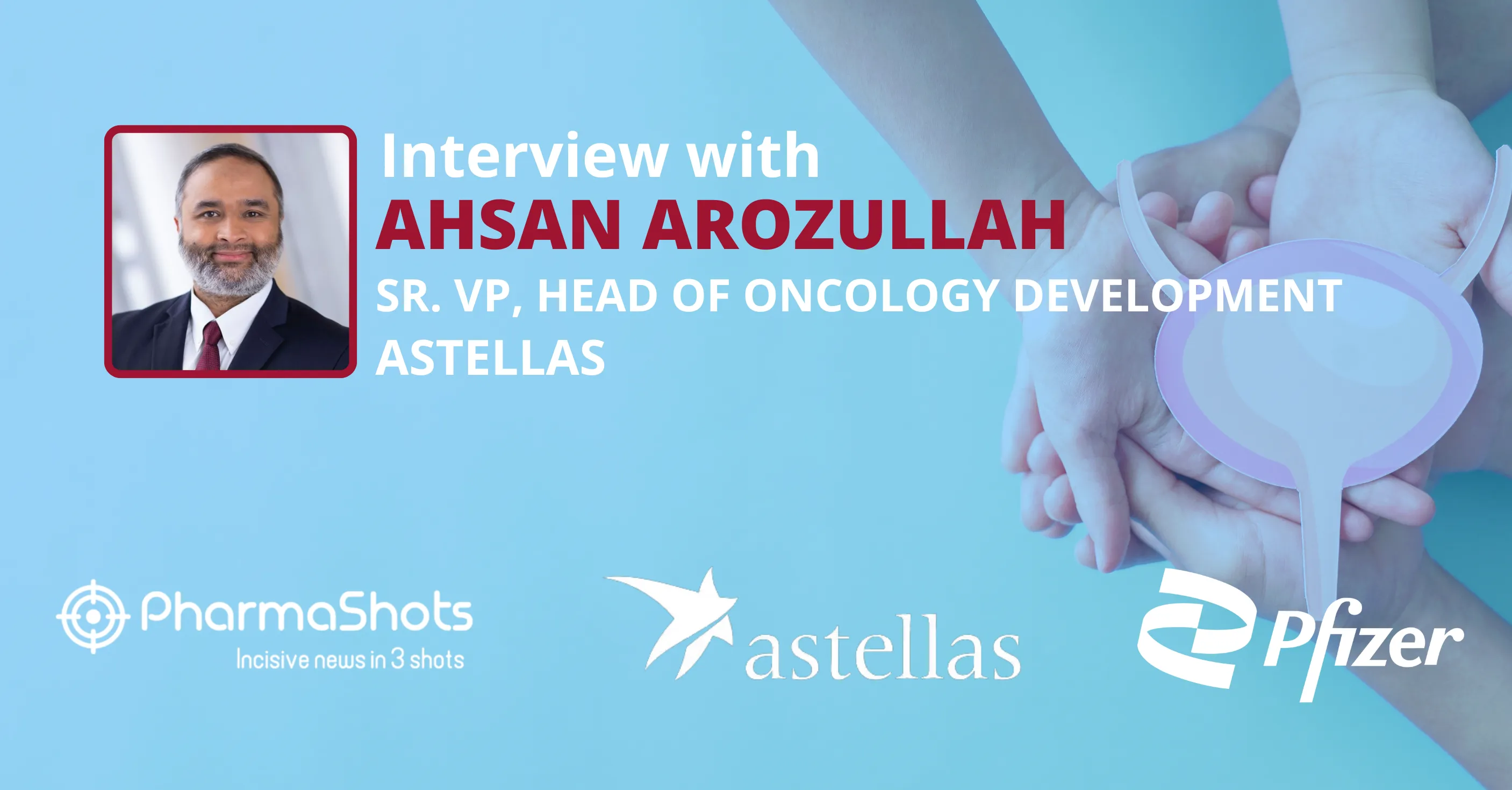
Unveiling FDA Acceptance: Ahsan Arozullah of Astellas Dives into Insights on PADCEV sBLAs for UC patients
Shots:
- Ahsan spoke about the US FDA acceptance for Priority Review of sBLAs for PADCEV and KEYTRUDA to treat patients with LA/mUC who are not eligible to receive cisplatin-containing CT
- He also talked about the study design and outcomes from the P-Ib/II (EV-103) clinical trial that supported the sBLA. The results from Dose Escalation/Cohort A were published in the Journal of Clinical Oncology
- The trial is conducted under a clinical collaboration between Astellas, Seagen and Merck to evaluate the combination of Seattle’s and Astellas’ ADC PADCEV and Merck’s KEYTRUDA, in patients with previously untreated mUC
Smriti: Would you please highlight the details (Mechanism of Action [MOA], Route of Administration [ROA], formulations, etc) of PADCEV [enfortumab vedotin]?
Ahsan Arozullah: PADCEV is a first-in-class antibody-drug conjugate (ADC) that is directed against Nectin-4, a protein located on the surface of cells and highly expressed in bladder cancer.[i] Nonclinical data suggest the anti-cancer activity of PADCEV is due to its binding to Nectin-4-expressing cells, followed by the internalization and release of the anti-tumor agent monomethyl auristatin E (MMAE) into the cell, which results in the cell not reproducing (cell cycle arrest) and in programmed cell death (apoptosis).
Smriti: Brief us about the study design of the P-Ib/II (EV-103) clinical trial evaluating PADCEV in combination with KEYTRUDA [pembrolizumab].
Ahsan Arozullah: The EV-103 trial (NCT03288545) is an ongoing, multi-cohort, open-label, multicenter phase 1b/2 study of enfortumab vedotin alone or in combination with pembrolizumab and/or chemotherapy in first- or second-line settings in patients with la/mUC and in patients with muscle-invasive bladder cancer (MIBC).
Smriti: What were the outcomes obtained from the P-Ib/II (EV-103) clinical trial based on which the sBLA was submitted to the US FDA?
Ahsan Arozullah: The approval is based on objective response rates (ORR) and median duration of response (DOR) in combined Dose Escalation/Cohort A and Cohort K of the phase 1b/2 EV-103 trial (NCT03288545, also known as KEYNOTE-869). In these EV-103 cohorts, patients treated with PADCEV in combination with pembrolizumab (n=121) obtained a 68% confirmed ORR (95% CI: 58.7 to 76.0) per RECIST v1.1 by blinded independent central review (BICR), with 12% of patients experiencing a complete response and 55% of patients experiencing a partial response. The median DOR per BICR for Dose Escalation/Cohort A was 22.1 months (range: 1.0+ to 46.3+) and was not reached (range: 1.2 to 24.1+) for Cohort K.2 The median number of treatment cycles (per 21-day treatment cycle) was nine in Dose Escalation/Cohort A and 11 in Cohort K.
The most common adverse reactions (≥20%), including laboratory abnormalities, in patients treated with PADCEV in combination with pembrolizumab were glucose increased (74%), aspartate aminotransferase increased (73%), rash (71%), hemoglobin decreased (69%), creatinine increased (69%), peripheral neuropathy (65%), lymphocytes decreased (64%), fatigue (60%), alanine aminotransferase increased (60%), sodium decreased (60%), lipase increased (59%), albumin decreased (59%), alopecia (52%), phosphate decreased (51%), decreased weight (48%), diarrhea (45%), pruritus (40%), decreased appetite (38%), nausea (36%), dysgeusia (35%), potassium decreased (35%), neutrophils decreased (32%), urinary tract infection (30%), constipation (27%), potassium increased (27%), calcium increased (27%), peripheral edema (26%), dry eye (25%), dizziness (23%), arthralgia (23%), and dry skin (21%).
Smriti: Highlight the characteristics of PADCEV & KEYTRUDA that contribute to their synergistic effect in the treatment of locally advanced or metastatic urothelial cancer.
Ahsan Arozullah: PADCEV plus pembrolizumab is expected to make a meaningful difference in the lives of responding patients with bladder cancer who are cisplatin-ineligible. Clinical trial data demonstrate that PADCEV plus pembrolizumab addresses an unmet need in urothelial cancer for cisplatin-ineligible patients.
Smriti: What makes this combo better than SoC of 1L UCC and other treatment options (if you can share a comparative analysis, that would be great)?
Ahsan Arozullah: Currently, cisplatin-based chemotherapy is the recommended treatment for patients first diagnosed with advanced bladder cancer. However, approximately half of patients with la/mUC are unfit for first-line cisplatin-based chemotherapy because of low/poor kidney function, poor performance status and/or comorbidities.PADCEV plus pembrolizumab is expected to make a meaningful difference in the lives of responding patients with bladder cancer who are cisplatin-ineligible. Clinical trial data demonstrate that PADCEV plus pembrolizumab addresses an unmet need in urothelial cancer for cisplatin-ineligible patients.
Smriti: Shed some light on the collaboration between Astellas, Seagen, and MSD. How does this collaboration work (details such as geographical ownness, royalty structure among other details)?
Ahsan Arozullah: Astellas and Seagen entered a clinical collaboration agreement with Merck to evaluate the combination of PADCEV and Merck’s pembrolizumab in patients with previously untreated metastatic urothelial cancer. This clinical collaboration agreement does not include commercialization activities.
Smriti: This is a sBLA plus the combination study already received BTD? So when can patients expect the start being prescribed this treatment option (estimated timeline)?
Ahsan Arozullah: This indication is now approved and available under accelerated approval based on tumor response rate and durability of response. Continued approval for this indication is contingent upon verification and description of clinical benefit in the confirmatory trials. The ongoing phase 3 EV-302/KEYNOTE-A39 trial (NCT04223856) is intended to serve as the U.S. confirmatory trial for the accelerated approval.
Source: Canva
About the Author:

Ahsan Arozullah
Ahsan M. Arozullah, M.D., M.P.H is the Senior Vice President, Head of Oncology Development at Astellas. He is a pharmaceutical executive with over 20 years of clinical research experience in the pharmaceutical industry and academic settings. His passion is to deliver lifesaving and life-changing therapies for patients. In his current position as Vice President of Medical Sciences-Oncology, Ahsan lead a global team of medical directors who provide world-class medical leadership to clinical development teams dedicated to creating the next generation of targeted oncology therapies. Ahsan obtained his BS degree in medicine and MD from the Northwestern University - The Feinberg School of Medicine, Chicago.
Tags

Senior Editor at PharmaShots. She is curious and very passionate about recent updates and developments in the life sciences industry. She covers Biopharma, MedTech, and Digital health segments along with different reports at PharmaShots.













